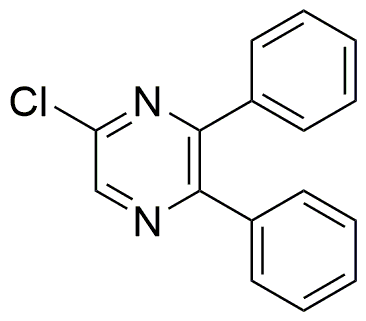5-Chloro-2,3-diphenylpyrazine is widely utilized in research focused on:
- Pharmaceutical Development: This compound serves as a key intermediate in the synthesis of various pharmaceuticals, particularly in developing anti-cancer agents due to its unique molecular structure that can interact with biological targets effectively.
- Agricultural Chemicals: It is used in formulating agrochemicals, including pesticides and herbicides, that are designed to enhance crop protection while minimizing environmental impact, making it a valuable asset in sustainable agriculture.
- Material Science: The compound is explored in the development of advanced materials, such as polymers and coatings, that require specific thermal and mechanical properties, providing durability and resistance to various environmental factors.
- Analytical Chemistry: It acts as a standard reference material in analytical chemistry, aiding in the calibration of instruments and ensuring accuracy in the detection of similar compounds in complex mixtures.
- Research in Organic Synthesis: The compound is a versatile building block in organic synthesis, allowing chemists to create a wide range of derivatives that can be tailored for specific applications in various fields, from electronics to pharmaceuticals.
General Information
Properties
Safety and Regulations
Applications
5-Chloro-2,3-diphenylpyrazine is widely utilized in research focused on:
- Pharmaceutical Development: This compound serves as a key intermediate in the synthesis of various pharmaceuticals, particularly in developing anti-cancer agents due to its unique molecular structure that can interact with biological targets effectively.
- Agricultural Chemicals: It is used in formulating agrochemicals, including pesticides and herbicides, that are designed to enhance crop protection while minimizing environmental impact, making it a valuable asset in sustainable agriculture.
- Material Science: The compound is explored in the development of advanced materials, such as polymers and coatings, that require specific thermal and mechanical properties, providing durability and resistance to various environmental factors.
- Analytical Chemistry: It acts as a standard reference material in analytical chemistry, aiding in the calibration of instruments and ensuring accuracy in the detection of similar compounds in complex mixtures.
- Research in Organic Synthesis: The compound is a versatile building block in organic synthesis, allowing chemists to create a wide range of derivatives that can be tailored for specific applications in various fields, from electronics to pharmaceuticals.
Documents
Safety Data Sheets (SDS)
The SDS provides comprehensive safety information on handling, storage, and disposal of the product.
Product Specification (PS)
The PS provides a comprehensive breakdown of the product’s properties, including chemical composition, physical state, purity, and storage requirements. It also details acceptable quality ranges and the product's intended applications.
Certificates of Analysis (COA)
Search for Certificates of Analysis (COA) by entering the products Lot Number. Lot and Batch Numbers can be found on a product’s label following the words ‘Lot’ or ‘Batch’.
*Catalog Number
*Lot Number
Certificates Of Origin (COO)
This COO confirms the country where the product was manufactured, and also details the materials and components used in it and whether it is derived from natural, synthetic, or other specific sources. This certificate may be required for customs, trade, and regulatory compliance.
*Catalog Number
*Lot Number
Safety Data Sheets (SDS)
The SDS provides comprehensive safety information on handling, storage, and disposal of the product.
DownloadProduct Specification (PS)
The PS provides a comprehensive breakdown of the product’s properties, including chemical composition, physical state, purity, and storage requirements. It also details acceptable quality ranges and the product's intended applications.
DownloadCertificates of Analysis (COA)
Search for Certificates of Analysis (COA) by entering the products Lot Number. Lot and Batch Numbers can be found on a product’s label following the words ‘Lot’ or ‘Batch’.
*Catalog Number
*Lot Number
Certificates Of Origin (COO)
This COO confirms the country where the product was manufactured, and also details the materials and components used in it and whether it is derived from natural, synthetic, or other specific sources. This certificate may be required for customs, trade, and regulatory compliance.


